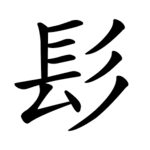Radical 190
Radical 190 meaning "hair" is 1 of 8 Kangxi radicals (214 radicals total) composed of 10 strokes.
| 髟 | ||
|---|---|---|
| ||
| 髟 (U+9ADF) "hair" | ||
| Pinyin: | biāo | |
| Bopomofo: | ㄅㄧㄠ | |
| Wade–Giles: | piao1 | |
| Cantonese Yale: | biu1 | |
| Jyutping: | biu1 | |
| Kana: | ヒョー hyō | |
| Kanji: | 髪冠 kamikanmuri (かみがしら) | |
| Hangul: | 머리 늘어질 meori neureojil | |
| Sino-Korean: | 표 pyo | |
| Hán-Việt: | tiêu | |
| Stroke order animation | ||
 | ||
In the Kangxi Dictionary there are 243 characters (out of 49,030) to be found under this radical.
Characters with Radical 190
| strokes | character |
|---|---|
| without additional strokes | 髟 |
| 2 additional strokes | 髠 |
| 3 additional strokes | 髡 髢 |
| 4 additional strokes | 髣 髤 髥 髦 髧 髨 髩 髪 |
| 5 additional strokes | 髫 髬 髭 髮 髯 髰 髱 髲 髳 髴 |
| 6 additional strokes | 髵 髶 髷 髸 髹 髺 髻 鬇 |
| 7 additional strokes | 髼 髽 髾 髿 鬀 鬁 鬂 |
| 8 additional strokes | 鬃 鬄 鬅 鬆 鬈 |
| 9 additional strokes | 鬉 鬊 鬋 鬌 鬍 鬎 鬏 |
| 10 additional strokes | 鬐 鬑 鬒 鬓 |
| 11 additional strokes | 鬔 鬕 鬖 鬗 鬘 鬝 |
| 12 additional strokes | 鬙 鬚 鬛 鬜 |
| 13 additional strokes | 鬞 鬟 鬠 |
| 14 additional strokes | 鬡 鬢 |
| 15 additional strokes | 鬣 |
| 17 additional strokes | 鬤 |
Literature
- Fazzioli, Edoardo (1987). Chinese calligraphy : from pictograph to ideogram : the history of 214 essential Chinese/Japanese characters. calligraphy by Rebecca Hon Ko. New York: Abbeville Press. ISBN 0-89659-774-1.
- Lunde, Ken (Jan 5, 2009). "Appendix J: Japanese Character Sets" (PDF). CJKV Information Processing: Chinese, Japanese, Korean & Vietnamese Computing (Second ed.). Sebastopol, Calif.: O'Reilly Media. ISBN 978-0-596-51447-1.
gollark: So, effectively ban certain opinions?
gollark: But you're not told whether you're one of the 50%.
gollark: How about we just randomly ban 50% of people from voting?
gollark: We haven't posted it to Twitter yet.
gollark: Evil idea to go with LyricLy's: at birth, you are randomly assigned a sexuality from a preapproved list and are not allowed to act in ways which do not fit with it.
This article is issued from Wikipedia. The text is licensed under Creative Commons - Attribution - Sharealike. Additional terms may apply for the media files.